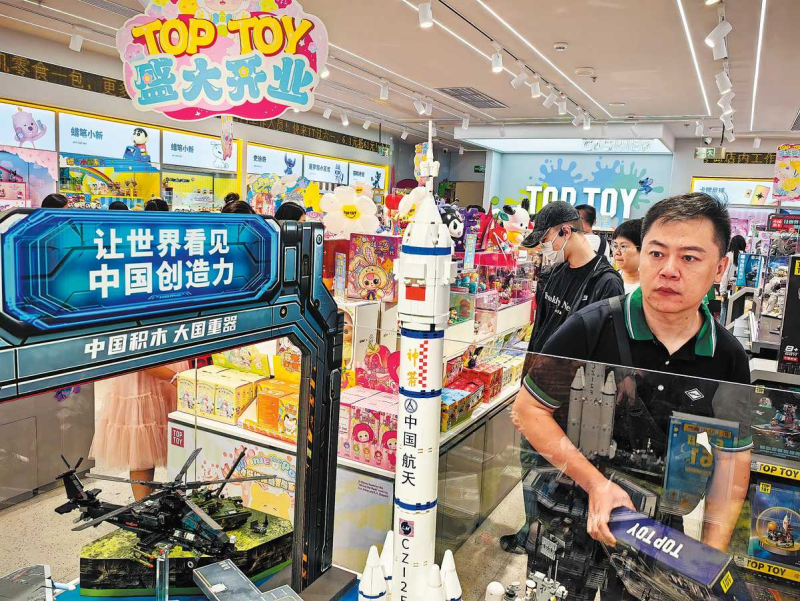'C-cool' trend reshaping global perceptions
Chinese brands integrating innovation with cultural expression

A humanoid robot puts on an exhibition during an aerospace sci-fi show at the China Science and Technology Museum in Beijing on June 28. JIN LIWANG/XINHUA
From TikTok dance trends to flying taxis and myth-based blockbuster video games, China is no longer just manufacturing the future, it's influencing global imagination.
A decade ago, the country's profile was tightly linked to economic growth and exports. Now, its global image is increasingly defined by innovation, creativity and cultural relevance, particularly among Gen Z worldwide.
"There is staying power in the Chinese cool factor; it's not a flash in the pan, it's not a passing fad," said Professor Lawrence Loh, a strategy and policy expert at the National University of Singapore.
"We are seeing an evolution from J-pop to K-drama to now a more holistic 'C-cool' trend."
The fusion of technology and storytelling has elevated Chinese pop culture to new heights. Video games such as Black Myth: Wukong, based on the classic novel Journey to the West, are drawing global praise for both their cinematic visuals and mythological depth. "It's a holistic shift, where tech meets culture, design, and daily life, and this wave is just starting", according to Ashley Dudarenok, founder of China-focused digital marketing company Alarice.
Platforms like TikTok and Xiaohongshu (RedNote) are at the center of this movement. TikTok, developed by ByteDance, is not only a global leader in short-form video but also ranked by Brand Finance as the world's seventh most valuable brand, ahead of Instagram and Facebook.
"Chinese tech brands like Huawei, BYD, Xiaomi, and TikTok are redefining global consumer expectations," said David Haigh, chairman and CEO of Brand Finance, a London-based brand valuation consultancy. "China is no longer just the 'factory of the world', it is transforming into a global innovation leader."

Visitors browse "China-chic" cultural and creative products in Beijing on June 1. YAN XIANG/FOR CHINA DAILY
Labubu, viral success
China's creative industries are no longer just reacting to Western trends; they are generating them. The viral success of the character Labubu, a quirky forest elf popularized through social media and collaborations with the Louvre and Uniqlo, is one telling example.
"The most notable example recently was the popularity of Labubu, with shoppers fighting each other to get one," said Tom Harper, a China expert at the University of East London.
Meanwhile, bite-sized Chinese micro-dramas on platforms like ReelShort and FlexTV are captivating millions of international viewers with high-drama narratives tailored for short attention spans.
Dudarenok attributes this rise to China's multi-pronged strategy: massive R&D investment, tax incentives for global co-productions, and a creative wave led by Gen Z content makers. In 2024 alone, China invested 3.6 trillion yuan ($502 billion) in research and development, according to the National Bureau of Statistics.
Amrita Banta, managing director of Agility Research & Strategy, highlighted another reason for this appeal: "Chinese pop culture is gaining traction among younger audiences because of its ability to blend traditional narratives with the latest trends and unique storytelling techniques."
She added that these innovations, combined with Gen Z's appetite for authenticity and global perspectives, position Chinese pop culture as both distinctive and accessible to international youth.
"The appeal of Chinese popular culture is largely due to how it offers something different to mainstream popular culture," Harper explained. "In some ways, that makes it similar to Hallyu, also known as the Korean Wave, and the popularity of Japanese popular culture in the 1990s and early 2000s.
Advancements in artificial intelligence, robotics, and smart mobility are reshaping perceptions of China's role in global innovation. In cities like Guangdong province's Guangzhou and Shenzhen, flying taxis have become a reality, while AI companies such as DeepSeek are emerging as serious competitors to ChatGPT based in the United States.
"The tech prowess of Chinese companies is across a broad spectrum, from the internet and social media to autonomous tech and AI," Loh said. "The emergence of agentic AI may spawn even greater 'coolness' products."
Banta said: "The launch of flying taxis in Guangzhou and Shenzhen demonstrates China's leadership in urban innovation and mobility infrastructure. These cities are becoming living laboratories for future-forward technologies."
Harper added in the case of Deep-Seek, this is due to how it appears less controlled by Western companies than OpenAI is. "It gives China an edge in perception, an independent tech path," he said.